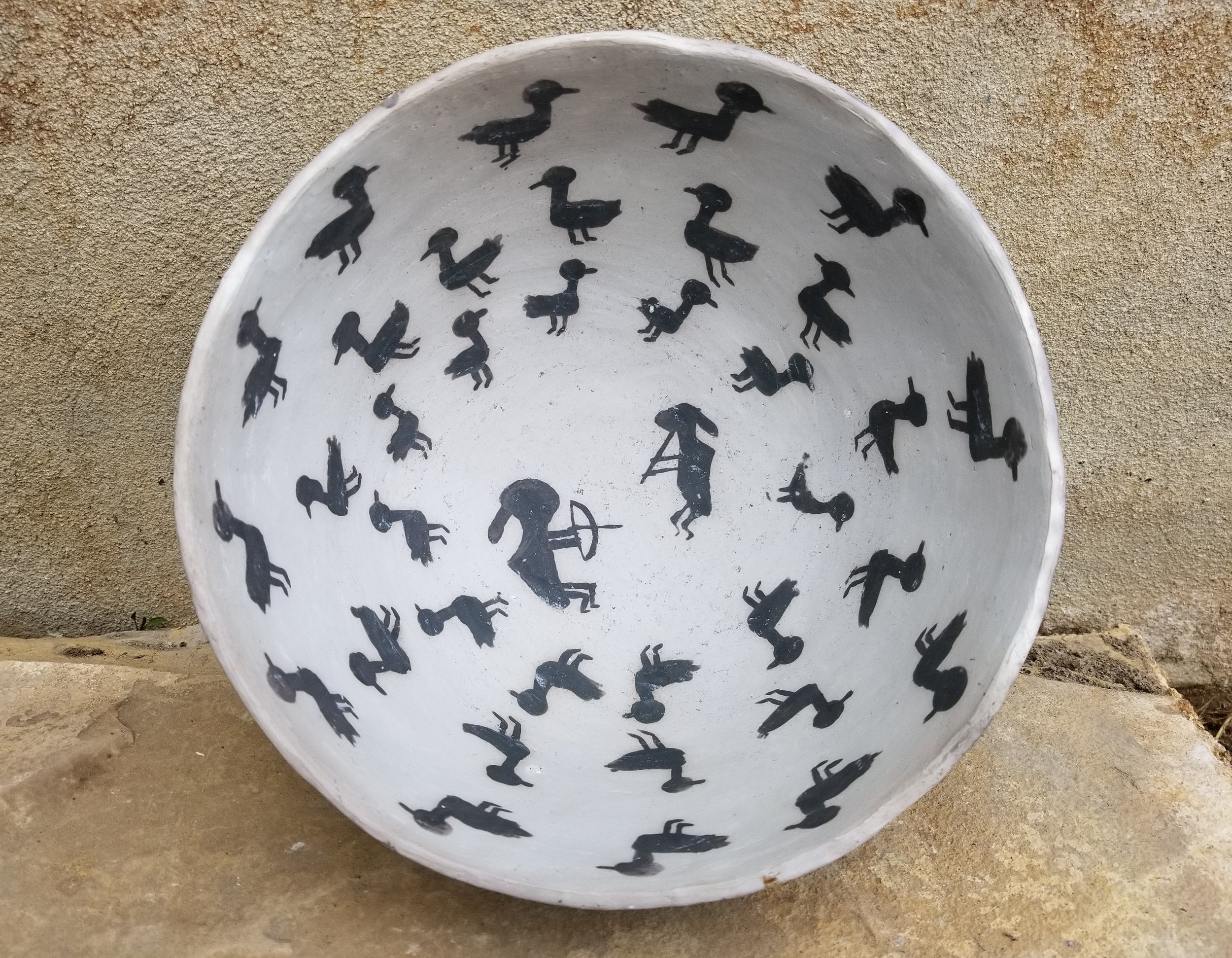MESA VERDE “DUCK HUNT” REPLICA BOWL. 8.25″ WIDE 4″ TALL
This bowl was made after a bowl residing in the museum at Mesa Verde National Park. The painting depicts a duck hunt with 2 figures, one with a bow and arrow and the other with a duck call. Pots representing scenes from every day life are rare in the Four Corners region unlike the mimbres pottery further south. This bowl has striking black on white contrast.
Kelly Magleby made this duck bowl and she is a master at primitive arts pottery. She writes: All of my ceramics are made using ancient building techniques and sustainably harvested materials. The process includes; hand-building using wild gathered clay, painting using a yucca leaf brush, using plant based or natural mineral based paints, and wood firing in a trench kiln or surface fire. Each pot is unique in form and character, and embodies its own story.
She is a big fan of primitive skills gatherings like Boulder Outdoor Survival School (BOSS) where she teaches primitive pottery skills, like the ones she showcases in this video.
I recently read this article and it reminded me of this bowl.
Men hunt and women gather? Large analysis says the long-held idea is flat-out wrong
By Jennifer Nalewicki
Scientists studying hunter-gatherer societies around the world discovered the stereotypes that men were hunters and women were gatherers was wrong.
The research compiled evidence from around the world to show that women participate in subsistence hunting in the majority of cultures. It’s long been assumed that men were hunters and women were gatherers, but a new study reveals that both sexes have been equally adept at hunting in hunter-gatherer cultures.
An international team of scientists made the finding after examining data culled from dozens of academic papers, published over the past 100 years, that focused on 63 hunter-gatherer societies and burials of female hunters from around the world, including groups in North America, Africa, Australia and Asia, according to a study published Wednesday (June 28) in the journal PLOS One.
“We were reading papers written by people who had lived with these groups and had studied their behavior,” study co-author Cara Wall-Scheffler, a professor and co-chair of biology at Seattle Pacific University, told Live Science. “They were looking at people and recording what they did.”
Of the foraging communities assessed, 79% contained women who were hunters, and their hunting status didn’t shift once they became mothers.
“The women would go out with many different tools — they had a very diverse tool kit all around the world — and if they saw an animal, they would kill it,” Wall-Scheffler said. “We were surprised by how the majority of groups showed women hunting, and there was no explicit taboo against that.”
The researchers also noted that more than 70% of female hunting expeditions were classified as “intentional,” meaning the women purposefully went out seeking meat, as opposed to engaging in opportunistic killings, in which they encountered animals while doing other tasks, such as foraging for plants, according to the study.
Most of these female hunters were “purposely hunting and going out to expressly hunt animals,” Wall-Scheffler said. “We were surprised that it wasn’t just opportunistic. Everyone in their community knew they would go hunting, and that was their job.”
Related: ‘Ghost footprints’ left by ancient hunter-gatherers discovered in Utah desert
Furthermore, female hunters weren’t hunting and trapping only small game, such as birds and rabbits. Rather, they were equal to male hunters when it came to big-game hunting in the Americas, making up roughly 50% of hunters targeting large animals such as deer and moose, according to the study.
“We reanalyzed the big-game burials from North and South America [in which people were buried with tools or animal bones], and prehistorically showed that women and men were 50/50 big-game hunters,” Wall-Scheffler said.
So, who’s to blame for the erroneous idea that men were hunters and women were gatherers?
Wall-Scheffler mentioned two books that likely helped solidify the idea: “Man the Hunter” (Aldine, 1968), based on a symposium of ethnographers, and a second book released 15 years later, titled “Woman the Gatherer” (Yale University Press, 1983).
This article also somehow reminded me of this other primitive skill ritual from bullet ants.
Self-Control Learned from Bullet Ants
Amongst the Amazonian Sateré-Mawé tribe, boys are required to place their hand into a glove interlaced with bullet ants — which administer one of the most painful stings in the world — and leave it on for ten minutes without uttering a sound.
Such rites of passage were once nearly universal in ancient cultures, as the quality tested — self-control — was considered a prerequisite to becoming a man. Inner poise was sought not for its own sake, however, but for the way it empowered more effective action. Self-control was developed not to avoid conflict, but to keep one’s head in the midst of it; not to deflect confrontation, but to choose the most advantageous circumstances in which to fight.
As societies became more atomized, anonymized, and bureaucratic, economic and governmental institutions arose which demanded a more docile citizenry, and individuals lost their sense of personal power, the connection between self-control and action enervated, and the quality began to be developed as an end in itself; not as a facilitator of outward action, but as a coping mechanism for staying inwardly sane in a frustrating, chaotic, unethical culture. For being put upon, with a smile.
Today, self-control has become the quality of character, but has lost its proactive premise.
Rather than addressing the societal and personal ills that are causing our stresses, we learn how to breathe and meditate so we can better bear up under them.
We’re taught to accept that which we cannot control, and concentrate on what we can, without noticing that the former category keeps growing and the latter keeps shrinking.
Acceptance may be a healthy act, but it is not a constructive one. What comes after?
If self-control isn’t a way to focus the beam of one’s action into an incendiary light . . .
it is only acquiescence to being a more manipulatable tool.




